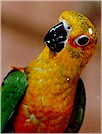 |
| Home |
| Who We Are |
| Save The Parrots |
| Books |
| Links |
| Volunteers |
| Articles |
| Avian Vet Listing |
| Email Us |
Reprinted from American Cage Bird Magazine, April, l992.
All Rights Reserved
Box 13, Point Arena, CA 95468 USA
PH: (213) 819-1723
macaws@parrotpro.com

During egg season, we check each hen twice a day for signs of egg binding, especially the young hens that are just beginning to lay. A mature hen that has produced babies for us every season since l981 unexpectedly became egg bound. At the morning nest check, she was in her nest, which is not unusual for her as she was already incubating three eggs. I decided to count the eggs anyway to see if we would have 3 or 4 this time. She came out and hung on the aviary wire, with a glazed expression on her face, eggbound and going into shock. The unexpected cold that night had caused the problem. The low went from 50 degrees the night before to 30 degrees, daytime had been 70 degrees, dropping to 50 degrees. This was the end of her second clutch in under 40 days.
Not wishing to waste time returning to the house for a net, I took off my jacket and caught her in it and rushed to the warm (85 degrees) bird room. There I placed her in a plastic carrier with clean, soft cloths on the bottom. The heating pad, on high, was placed under the carrier, and the hole was covered with thick folds of toweling to retain the heat and to darken the area, in order to calm her.
To raise her body temperature, I immersed her in a bowl of warm water (102 degrees) up to her neck, and held her there for as long as she would tolerate it, about a minute. I kept my hands in the water, making sure it was not too hot for her. I found these directions in a bird book.
Now she was wet and mad, and sure to get chilled. I used a hair dryer to quickly dry her. They are a good source of portable heat. I was sure to keep the dryer far enough away not to burn her, and I shielded her face so her eyes would not dry out.
Her vent was closed and dry. To lubricate her vent and gently open it, I used a canary feeding tube, which was attached to a sterile syringe and filled with mineral oil. Olive oil would have been my second choice. A canary tube is a steel needle with a ball tip that fits a syringe.
I then felt the egg position, through her abdomen; it was just about all the way down to the vent. It was not broken, so I gently pressed it the last 1/4 inch toward the opening. Four times I inserted the canary tube about 1/2 inch into her vent, and very gently moved it around the egg, depositing a total of 1 cc of oil into her vent. Between oiling, I massaged her abdomen, pressing gently toward the vent. She was clinging to the wire door, and was still somewhat frightened, so extreme care had to be taken not to break the egg. I kept the hair dryer on her. An hour had already passed.
About two hours after we started, she began to labor. I could see her abdomen contracting at regular intervals of about 30 seconds. She stood in the pile of warm cloths, on the bottom of the carrier. Her vent was opening; we would soon have an answer either way. Twenty minutes of contractions, and we had our egg. She was given some Ringers lactate, orally. Gatorade is a good substitute. Our birds like the orange flavor the best. These replace lost fluids, electrolytes and minerals which are lost during stressful situations.
Earlier, I had removed the other three eggs from the nest, as they were getting cold, and placed them in the incubator. The bird was very tired, and I kept her in the house for an hour before placing her and all four eggs back in the flight. I didn't feel right about that, and so I brought her back into the house to rest for 24 hours. She really needed the rest, more than we needed the clutch of eggs. Of course, by the time she was sufficiently recovered to return to her aviary, she had forgotten all about her eggs.
Five days after the eggbinding, she is back to normal. She is enjoying spring with no responsibilities, and I have some tiny Jendays to incubate and feed!